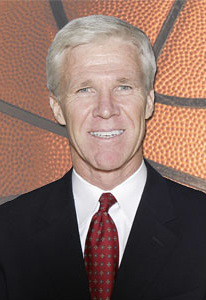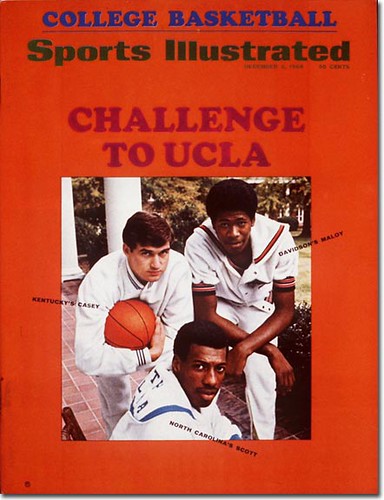
(Click here for front page of ESPN.com College Basketball)
By Andy Glockner
ESPN.com
Quick: Name the best "RPI opponent" in the country last season.
Ohio State was atop the RPI at the end of the regular season, but the Buckeyes didn't provide the best bang for your RPI buck. Neither did Memphis, Florida, UCLA, Kansas, Wisconsin or North Carolina, even though all six of those elite programs also finished in the top 11 in the RPI. Why? Because all those teams were very likely to beat you, negating some of the benefit their strong win/loss records and strengths of schedule provided for your RPI.
As your own winning percentage is 25 percent of your RPI, you must add relative "beatability" into the equation. When you do, the answer probably will surprise you: It's Davidson. In addition to finishing the regular season with a 25-4 Division I record, the Wildcats' overall schedule (including games in the underrated Southern Conference, which ended up 19th of the 31 conferences in RPI) was strong enough to give the Wildcats the 10th-best combination of winning percentage and SOS in the country (measured with winning percentage being worth twice as much as SOS, per the RPI formula). Now weigh the fact that most Top 25 teams would be strongly favored over Davidson at home, and it's a no-brainer.
Don't worry if you didn't know that; you'd be hard-pressed to find a Division I head coach who would have answered that correctly. The evidence? The best RPI opponent in D-I in 2005-06 was Bucknell, and the Bison had one Top 50 RPI game on their schedule this past season (at Xavier). Bucknell -- a team that had won a first-round NCAA Tournament game each of the past two seasons -- had been weakened by graduation, but still was a very good bet to get 20-plus wins (it ended up 22-9). The Bison should have been on every major-conference team's speed dial, but almost no one wanted any part of them.
"The RPI thing is something I try to influence, because we have a beautiful place to play and our RPI is good, so we're not going to hurt you if you beat us, or maybe even if we beat you," said Bucknell coach Pat Flannery, who's always on the hunt for home-and-home series.
The Bucknell example speaks to the larger issue across Division I. Despite the huge amount of money at stake annually in today's college hoops world, it's clear that the vast majority of programs still don't understand how best to exploit the most fundamental of opportunities: nonconference scheduling.
Despite what the NCAA selection committee says every season about RPI being only one evaluation metric, it's an incredible predictor of NCAA Tournament inclusion, especially for major-conference teams. This past season, 37 of the top 40 teams in the RPI made the field of 65 (and only No. 30 Air Force had any type of reasonable gripe about being excluded). In 2005-06, it was 36 of the top 38 (No. 21 Missouri State and No. 30 Hofstra were the two controversial exclusions, although I agreed with both decisions). In 2004-05, it was a perfect 40 of 40 (No. 43 Miami (Ohio) was the first omission). The 2005-06 Cincinnati squad, which lost star Armein Kirkland to injury midway through the season, was the only BCS conference team in those three years to miss the NCAAs with an RPI of 40 or better (and the Bearcats finished at No. 40).
Why is that notable? Well, as Andy Katz reported Wednesday, major-conference teams that just missed this season's NCAA Tournament, such as Clemson (RPI No. 46) and Syracuse (No. 50), have no intention of changing their nonconference scheduling philosophy. Given what's at stake and how minimally a schedule would need to be tweaked for a program to gain significant RPI leverage, that's a mistake.
"We're looking to play good teams," Syracuse coach Jim Boeheim said. "[In addition to Baylor], we also got Wichita State and Drexel and Hofstra. Can you get 10 of those [teams]? We're still going to play Colgate and play Cornell. We're going to play them for 100 years. We've got Rhode Island [next season], which should be good. Saint Joe's has everyone back. We think we have good RPI teams [on next season's schedule]."
 Loyalty and a sense of history are great, but making the NCAA Tournament -- and getting the best seed possible -- should be the first goal for any program each season. Although it's admirable on certain levels for Boeheim to say Syracuse will play teams such as Colgate annually, it's also not smart for the Orange to commit to do that. The Raiders have finished better than No. 238 in the RPI only once in the past eight seasons (No. 199 in 2001-02), and this past season, Colgate ranked 266th in combined winning percentage/SOS. Basically, the Raiders are an annual albatross on Syracuse's RPI.
Loyalty and a sense of history are great, but making the NCAA Tournament -- and getting the best seed possible -- should be the first goal for any program each season. Although it's admirable on certain levels for Boeheim to say Syracuse will play teams such as Colgate annually, it's also not smart for the Orange to commit to do that. The Raiders have finished better than No. 238 in the RPI only once in the past eight seasons (No. 199 in 2001-02), and this past season, Colgate ranked 266th in combined winning percentage/SOS. Basically, the Raiders are an annual albatross on Syracuse's RPI.That doesn't mean teams like Syracuse can't schedule -- and overcome -- those games. It just means that, at best, it's removing some margin for error -- margin Syracuse needed this season after it lost at home to Wichita State and Drexel. At worst, that one game could cost a team favorable seeding or, every so often, even an NCAA berth.
Look what would have happened to Syracuse this past season had the Orange simply been able to replace Colgate with Davidson.
As estimated by Ken Pomeroy's efficiency ratings and giving Syracuse standard home-court advantage, Colgate is a nearly automatic home win for Syracuse and Davidson would win one in every six meetings. Given that Rule 1 of RPI Betterment is "Don't lose at home," it appears Colgate is the smarter and safer choice. That's not the case, though. Davidson's record (rolled into Factor II, worth 50 percent of a team's RPI) is so much better than Colgate's that, even assuming Syracuse never loses to Colgate and accounting for the occasional loss to the Wildcats, Syracuse is much better off playing Davidson.
How much better? A quick crunch of the numbers shows that making that one switch in the schedule this season would have, on average, improved Syracuse's RPI by about 0.0057 -- or in other words, nine RPI spots this past season. That would have pushed the Orange from No. 50 to No. 41, right on the brink of what recently has been near-lock status for the NCAA Tournament. Five times out of six, the actual bump would be bigger. Just from one game.
Again, this isn't a rip on Syracuse; in playing home games against Penn, Holy Cross and Hofstra last season, in addition to Wichita State and Drexel, the Orange showed they "get it" more than most teams of their ilk. The Orange just happened to lose two of those games, which is killer in the new RPI formula.
The morals of the story? Understand the way the RPI works -- all wins are created equal -- and don't be afraid to schedule up. Top 50 programs can play opponents 150-200 RPI spots better than some of the worst teams on their current schedule with a minimal increase in the risk of a loss. The programs that more rapidly understand this risk/reward equation will reap the benefits -- a good situation to be in when those benefits include millions of extra dollars in NCAA Tournament revenues and TV exposure.
No one expected Davidson to be this good this season, but now the nation has been warned. The Wildcats didn't have a senior on their roster and should be a lock to have 22-plus wins again next season. As such, we'll find out who really does get it when we see which teams schedule Davidson in 2007-08.










2 comments:
I don't know if I told you or not, but I nominated your blog for a Blogger award.
Thanks, Trabert!!
Do you have a link?
Post a Comment